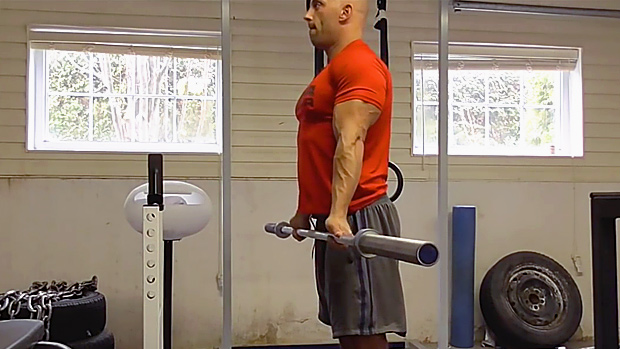How many times a week should you bench or squat or deadlift or even train abs? Great question, and like most things in the strength and conditioning world, a hotly debated one. This article will try to offer a more measured perspective.
Frequency versus Intensity
There are two main variables in exercise program design, frequency, and intensity. Frequency refers to how often you perform something, either the total number of workouts or a specific movement like the bench press, usually in a one-week period. This article will refer to the former as "overall frequency" and the latter as "frequency of training each area."
Intensity refers to the level of difficulty of the workout. With cardio we'd use heart rate to measure intensity, but since the subject is weight training we'll use a percentage of the one-rep max (%1RM). Precise as that may sound, it can still be a little fuzzzy. If your 1RM bench press is 365 pounds and you lift 315 pounds, that's 86% of the 1RM, usually considered moderate to high intensity.
But aren't we missing something crucial to really classify the intensity of that set? We need to know how many reps were performed. If you can lift 365 pounds and you hit 315 pounds for one rep, that's a relatively easy set. Three hundred and fifteen pounds for three reps is more challenging but certainly doable; that sounds like moderate intensity to me.
Three hundred and fifteen pounds for six reps sounds like a balls-out high intensity set that would be almost as hard to complete as 365 for one rep.
To address this, I propose the term "overall intensity," which combines the intensity of the load calculated as a percentage of 1RM and the number of reps performed at that weight. To do this perfectly you'd need to know what your own conversion chart is, but to save time here's a quick conversion chart that works well.
| Reps Performed | Estimated %1RM | Reps Performed | Estimated %1RM |
| 1 | 100% | 7 | 84.9% |
| 2 | 96.8% | 8 | 83.0% |
| 3 | 93.7% | 9 | 81.0% |
| 4 | 91.2% | 10 | 79.2% |
| 5 | 88.8% | 11 | 77.5% |
| 6 | 86.8% | 12 | 75.9% |
This chart predicts how many reps you should be able to perform lifting a certain percentage of your one-rep max. It also allows you to calculate overall intensity. Simply take the %1RM that you're lifting and then calculate how many extra reps you completed on that particular set.
You must lift something once for it to count, so an extra rep is simply the number of additional reps you completed after the first rep. Once you calculate how many extra reps were completed, move that number of levels up the chart (each rep is one level).
Here are a few examples.
- 1RM: 365 pounds
- Set completed: 315 x 3 reps
- Extra reps: 3 - 1 = 2 extra reps
- 315/365 = 86% intensity (6RM estimated max)
- Overall Intensity (go up two levels) = 91.2% intensity
- 1RM: 365 pounds
- Set completed: 315 x 1 rep
- Extra reps: 1 - 1 = 0 extra reps
- 315/365 = 86% intensity (6RM estimated max)
- Overall Intensity (go up 0 levels) = 86% intensity
- 1RM: 365 pounds
- Set completed: 315 x 6 reps
- Extra reps: 6 - 1 = 5 extra reps
- 315/365 = 86% intensity (6RM estimated max)
- Overall Intensity (go up five levels) = 100% intensity
(Confused? Post your 1RM and the set completed in the forums and I'll help you figure it out.)
Why Should We Care About This?
You might be wondering how this will affect your training. I'll try to make that clear.
We must balance frequency and intensity. If frequency is too low, the stimuli won't add up, resulting in a poor training effect. Too low an intensity is just wasting time. If the frequency is too high, the likelihood of chronic injuries or over training increases. Ditto if the intensity is too high, and throw in acute injuries as well.
In the beginning it's easy. Just train at a moderate intensity 2 – 3 times a week. You're not used to anything so you respond to just about everything, and make great progress. Usually as a person starts to lift heavier and harder they find they can't recover quite as fast.
They need more volume and intensity to make the muscle grow, and that added intensity increases recovery time requiring the training frequency of each area to be reduced. But the story does not and should not end there.
Optimal Frequency and Intensity
A picture is worth a thousand words. Below is a graph that outlines what the optimal overall frequency, frequency of training each area, and overall training intensity might be over a lifter's career, followed by a discussion of the key points.

There are several key points to this graph.
- The red line with the gray shading (center section) represents the suggested frequency of training sessions a lifter should perform per week. Notice that it generally rises over a lifter's career.
- The dark blue line with the light blue shading (bottom section) represents the suggested frequency of training each area or movement per week. Notice that it decreases for the first few years and then increases later in a lifter's career.
- The dark green line with the light green shading (top section) represents the suggested overall intensity a lifter should train at per training session. Notice that it steadily increases for a few years, peaks, and then gradually decreases but remains quite high throughout the rest of the career.
- Note: Don't get hung up on the exact timeline given, or if you've trained for more than 10 years. The point of this graph is to serve as a general guide showing how things will progress over the course of one's training career.
What Does This Graph Teach Us?
- When starting an exercise program, a lifter should workout 2-3 times a week, training each area 2-3 times a week (thus following a total body routine). Their overall intensity should be light (<70%) to moderate (<85%). A great example is Starting Strength by Mark Rippetoe.
- After a year or two, hopefully a lifter has achieved a "decent" level of strength. His overall training frequency should remain the same or increase, the frequency of training each area should decrease, and the overall intensity of training should continue to increase.
- After several years and/or achieving a "good" level of strength, the overall training frequency will likely increase, up to 4-5 sessions a week. The frequency of training each area might remain the same or increase, and the overall intensity of training will peak.
- After a lifter has been lifting for many years and/or has achieved a "great" level of strength, the overall training frequency will likely continue to increase (assuming they wish to continue to make progress), the frequency of training each area should increase, and the overall intensity of training will slightly decrease to accommodate the higher frequency.
Let's start with the intermediate lifter. The graph has him or her training intensely during 3-5 sessions a week and likely following a split routine. It's safe to say at least part of one's lifting career should be spent training this way as this type of training will increase hypertrophy and teach a lifter to recruit the Type II B muscle fibers.
Going balls out and performing super intense sets that leave you sore for days has value in the ability to improve neuromuscular coordination, fully fatigue and stimulate the muscle, and build mental and physical toughness. Exercise programs set up like this also tend to allow the lifter more time to focus on general assistance exercises devoted to all parts of the body and can help bring up weak points.
However, once a lifter becomes significantly more advanced (most people reading this likely aren't at that stage yet, but hopefully will get there), that type of full throttle training is probably no longer optimal – at least not on a regular basis – especially if strength is the goal.
Once you're advanced, it's easier to outwork your recovery abilities. This type of lifter will likely get better results by reducing the intensity slightly and significantly increasing the frequency to compensate for the reduction in intensity.
The increased frequency will allow the lifter to further refine his technique while allowing more time be spent practicing specific assistance exercises required to bring up an already impressive lift. At this stage, general assistance exercises usually take a back seat and are used to maintain balance and prevent injury, as opposed to increase performance.
For example, the lifter in our scenario might be able to bench 315 pounds for six reps once a week, but finds it extremely taxing and basically wrecks him for the next several days. It might be better for that lifter to instead choose 315 pounds for 3-4 reps, but now perform that set two, three, even four times a week.
That argument, however, doesn't hold water with a weaker lifter who can perform 200 pounds for six, but instead opts to do 200 pounds for a double or triple more frequently. That lifter is likely leaving much of his muscle "untapped," and needs that intense set to open up and "awaken" their muscles.
Closing Arguments
Not every lifter is the same, nor is every lift the same, which is why you rarely meet experienced lifters suggesting that beginners and rookies should train the same or that the bench press and deadlift should be trained with the same frequency.
That said, taking a long-term approach to program design and knowing where a lifter is today versus where they want to go tomorrow is extremely helpful. Skipping any of the significant stages presented here might ultimately cause the trainee to miss out on his or her full lifting potential.





